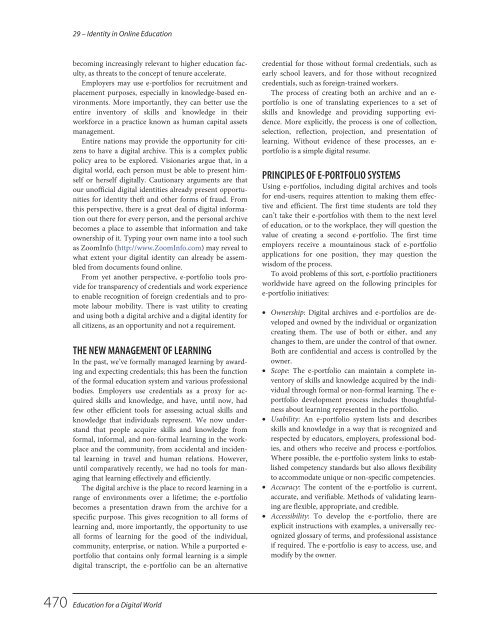Education for a Digital World Advice, Guidelines and Effective Practice from Around Globe, 2008a
Education for a Digital World Advice, Guidelines and Effective Practice from Around Globe, 2008a
Education for a Digital World Advice, Guidelines and Effective Practice from Around Globe, 2008a
Create successful ePaper yourself
Turn your PDF publications into a flip-book with our unique Google optimized e-Paper software.
29 – Identity in Online <strong>Education</strong><br />
becoming increasingly relevant to higher education faculty,<br />
as threats to the concept of tenure accelerate.<br />
Employers may use e-portfolios <strong>for</strong> recruitment <strong>and</strong><br />
placement purposes, especially in knowledge-based environments.<br />
More importantly, they can better use the<br />
entire inventory of skills <strong>and</strong> knowledge in their<br />
work<strong>for</strong>ce in a practice known as human capital assets<br />
management.<br />
Entire nations may provide the opportunity <strong>for</strong> citizens<br />
to have a digital archive. This is a complex public<br />
policy area to be explored. Visionaries argue that, in a<br />
digital world, each person must be able to present himself<br />
or herself digitally. Cautionary arguments are that<br />
our unofficial digital identities already present opportunities<br />
<strong>for</strong> identity theft <strong>and</strong> other <strong>for</strong>ms of fraud. From<br />
this perspective, there is a great deal of digital in<strong>for</strong>mation<br />
out there <strong>for</strong> every person, <strong>and</strong> the personal archive<br />
becomes a place to assemble that in<strong>for</strong>mation <strong>and</strong> take<br />
ownership of it. Typing your own name into a tool such<br />
as ZoomInfo (http://www.ZoomInfo.com) may reveal to<br />
what extent your digital identity can already be assembled<br />
<strong>from</strong> documents found online.<br />
From yet another perspective, e-portfolio tools provide<br />
<strong>for</strong> transparency of credentials <strong>and</strong> work experience<br />
to enable recognition of <strong>for</strong>eign credentials <strong>and</strong> to promote<br />
labour mobility. There is vast utility to creating<br />
<strong>and</strong> using both a digital archive <strong>and</strong> a digital identity <strong>for</strong><br />
all citizens, as an opportunity <strong>and</strong> not a requirement.<br />
THE NEW MANAGEMENT OF LEARNING<br />
In the past, we’ve <strong>for</strong>mally managed learning by awarding<br />
<strong>and</strong> expecting credentials; this has been the function<br />
of the <strong>for</strong>mal education system <strong>and</strong> various professional<br />
bodies. Employers use credentials as a proxy <strong>for</strong> acquired<br />
skills <strong>and</strong> knowledge, <strong>and</strong> have, until now, had<br />
few other efficient tools <strong>for</strong> assessing actual skills <strong>and</strong><br />
knowledge that individuals represent. We now underst<strong>and</strong><br />
that people acquire skills <strong>and</strong> knowledge <strong>from</strong><br />
<strong>for</strong>mal, in<strong>for</strong>mal, <strong>and</strong> non-<strong>for</strong>mal learning in the workplace<br />
<strong>and</strong> the community, <strong>from</strong> accidental <strong>and</strong> incidental<br />
learning in travel <strong>and</strong> human relations. However,<br />
until comparatively recently, we had no tools <strong>for</strong> managing<br />
that learning effectively <strong>and</strong> efficiently.<br />
The digital archive is the place to record learning in a<br />
range of environments over a lifetime; the e-portfolio<br />
becomes a presentation drawn <strong>from</strong> the archive <strong>for</strong> a<br />
specific purpose. This gives recognition to all <strong>for</strong>ms of<br />
learning <strong>and</strong>, more importantly, the opportunity to use<br />
all <strong>for</strong>ms of learning <strong>for</strong> the good of the individual,<br />
community, enterprise, or nation. While a purported e-<br />
portfolio that contains only <strong>for</strong>mal learning is a simple<br />
digital transcript, the e-portfolio can be an alternative<br />
credential <strong>for</strong> those without <strong>for</strong>mal credentials, such as<br />
early school leavers, <strong>and</strong> <strong>for</strong> those without recognized<br />
credentials, such as <strong>for</strong>eign-trained workers.<br />
The process of creating both an archive <strong>and</strong> an e-<br />
portfolio is one of translating experiences to a set of<br />
skills <strong>and</strong> knowledge <strong>and</strong> providing supporting evidence.<br />
More explicitly, the process is one of collection,<br />
selection, reflection, projection, <strong>and</strong> presentation of<br />
learning. Without evidence of these processes, an e-<br />
portfolio is a simple digital resume.<br />
PRINCIPLES OF E-PORTFOLIO SYSTEMS<br />
Using e-portfolios, including digital archives <strong>and</strong> tools<br />
<strong>for</strong> end-users, requires attention to making them effective<br />
<strong>and</strong> efficient. The first time students are told they<br />
can’t take their e-portfolios with them to the next level<br />
of education, or to the workplace, they will question the<br />
value of creating a second e-portfolio. The first time<br />
employers receive a mountainous stack of e-portfolio<br />
applications <strong>for</strong> one position, they may question the<br />
wisdom of the process.<br />
To avoid problems of this sort, e-portfolio practitioners<br />
worldwide have agreed on the following principles <strong>for</strong><br />
e-portfolio initiatives:<br />
• Ownership: <strong>Digital</strong> archives <strong>and</strong> e-portfolios are developed<br />
<strong>and</strong> owned by the individual or organization<br />
creating them. The use of both or either, <strong>and</strong> any<br />
changes to them, are under the control of that owner.<br />
Both are confidential <strong>and</strong> access is controlled by the<br />
owner.<br />
• Scope: The e-portfolio can maintain a complete inventory<br />
of skills <strong>and</strong> knowledge acquired by the individual<br />
through <strong>for</strong>mal or non-<strong>for</strong>mal learning. The e-<br />
portfolio development process includes thoughtfulness<br />
about learning represented in the portfolio.<br />
• Usability: An e-portfolio system lists <strong>and</strong> describes<br />
skills <strong>and</strong> knowledge in a way that is recognized <strong>and</strong><br />
respected by educators, employers, professional bodies,<br />
<strong>and</strong> others who receive <strong>and</strong> process e-portfolios.<br />
Where possible, the e-portfolio system links to established<br />
competency st<strong>and</strong>ards but also allows flexibility<br />
to accommodate unique or non-specific competencies.<br />
• Accuracy: The content of the e-portfolio is current,<br />
accurate, <strong>and</strong> verifiable. Methods of validating learning<br />
are flexible, appropriate, <strong>and</strong> credible.<br />
• Accessibility: To develop the e-portfolio, there are<br />
explicit instructions with examples, a universally recognized<br />
glossary of terms, <strong>and</strong> professional assistance<br />
if required. The e-portfolio is easy to access, use, <strong>and</strong><br />
modify by the owner.<br />
470 <strong>Education</strong> <strong>for</strong> a <strong>Digital</strong> <strong>World</strong>


















